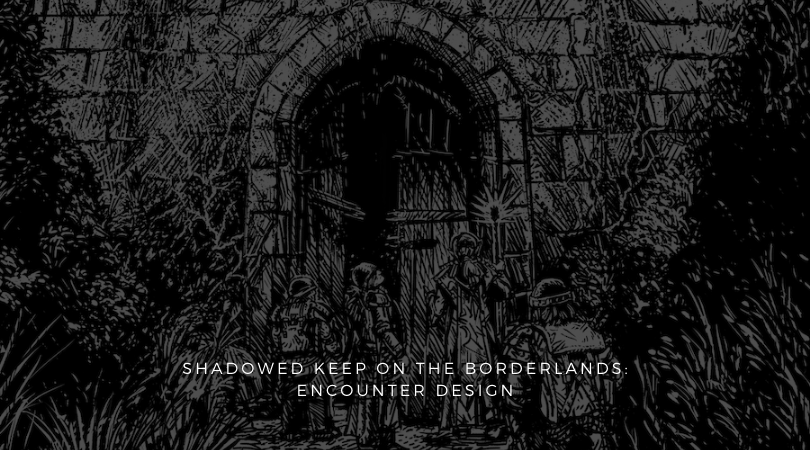Shadowed Keep: Encounter Design

In my final post about Shadowed Keep on the Borderlands’s design I wanted to talk about my general philosophy behind individual encounter design. But to set the scene, sadly I must first rant.
In my opinion, modules are getting harder. What I mean by this is that designers seem to be writing adventurers to challenge the super-optimised group – the kind of players who tweak their characters to the nth degree. There is absolutely nothing wrong with that style of play—in fact I do it myself on occasion. That said, writing to challenge the toughest, best prepared players inevitably rogers senseless the less prepared, casual, or god-forbidden, neophyte player who is just getting started with the hobby.
When I was on Living Greyhawk’s Circle of Six I witnessed a kind of bizarre, escalating arms race in which module designers and players each strove to outdo one another with the toughest legal builds. I like a challenge as next as the next player—there is nothing better than crushing the evil villain and saving the day—but similarly I don’t want every adventure or encounter I play to be balls to the wall, crazy dangerous.
As the “arm’s race” intensified, I got the impression that some modules were nothing more than a series of rather tough fights —the background, plot, environment, NPCs and everything else that makes a great module seemed to be more and more pushed to the periphery of the design process.
That was not going to be the case with Shadowed Keep on the Borderlands. Don’t get me wrong, there are challenging encounters in this adventure, but there are also very easy ones.
My Encounter Design Principles
So with that rant out of the way, here are the principles (or “the spine”) of my encounter design philosophy:
Meaningful Choices
I loath railroading modules with the fiery passion of a thousands burning stars and I believe most players feel that way. At almost every juncture, the players should have a choice about how they proceed. Do they try the tower or the donjon first? How do they get into the tower? Do they deal with the goblins or dare the undercrypts?
Reward Clever Play
Players who pay attention, come up with clever ideas, remain observant and so on should be rewarded. Skill use should be encouraged. I tend to break skills down into two basic, broad categories: combat (things like Stealth, Acrobatics) and knowledge (Appraise, Knowledge, Diplomacy etc.) Both sets of skills should be useful in the adventure. After all, if a rogue takes Appraise or a wizard takes Knowledge (engineering) and never gets to use them, that sucks. Part of the dungeon (an inessential part) should only be accessible if the characters are paying attention.
Logically Consistent
Each encounter should be logically consistent with the history, background and current condition of the keep. What was the room once used for? What is it being used for now? Can the characters make educated guesses based on the conditions, contents and decorations of the area?
Danger
Obviously, danger lurks in the Shadowed Keep, and this danger should grow greater the further away from ground level (in either direction) the characters venture. So, for example, the upper levels of the bandit’s tower and the upper level of the donjon are more dangerous that than the floor beneath.
Avoid the 15-Minute Adventuring Day
I hate the 15-minute adventuring day. Such days normally come about because the challenges the characters face are tough, forcing them to expend precious resources quickly. Encounters should generally be easier so the characters can explore more areas without having to rest. This builds a sense of achievement and progression and leads to more “organic” forays where the characters stop to rest after they have cleared a whole section rather than when they have run out of healing spells.
Stuff for Different Classes and Races to Do
All characters cannot be equally engaged in every encounter all the time. That said, some classes (clerics, rogues, paladins etc.) are particularly suited toward certain kinds of activity. They should be given their time in the limelight. Similarly, are their places or environmental conditions that only Small characters can take advantage of?
Environment
Fights don’t happen in featureless rooms. Furniture as well as unique features like rafters, chandeliers and so on can all be used by canny combatants to gain advantage. Include these where appropriate. Similarly, a decent amount of detail makes an encounter come alive. What do the tapestries depict? Is there graffiti on the walls? Are small, low-value treasures yet hidden within the keep, and can perceptive characters uncover said treasures?
Diplomacy
Not all encounters should end with a fight. Where appropriate, characters should be able to use cunning, duplicity and even diplomacy to “win.”
Varied Opponents
This is particularly tricky to achieve in the goblin lair, as goblin tribes tend to be made up of basic warrior types. However, do the goblins pay mercenaries? Are they hosting emissaries from other tribes? Do different tribal warriors use different weapons or fighting styles?
Be Easy to Run
This is huge; the best module in the world can be a complete disaster if it is hard to understand, prepare or run. Encounter text should do as much of the work for a GM as possible so that preparation is quick and simple.
The Final Word
And that’s it—a look at the behind-the-curtain thoughts that go into designing the Shadowed Keep. I hope you found them useful and interesting.
Do you do something similar when designing modules (either professionally or privately)? Sign up for a paid Gameatory account, join our exclusive Slack channel and let me know.

Member discussion